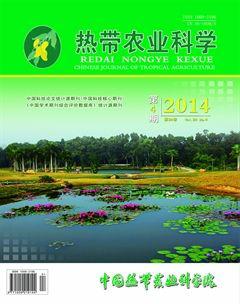柱花草花藥離體培養研究
單國燕等
摘 要 以熱研2號柱花草花藥為外植體,研究不同植物生長調節劑 、培養基以及低溫預處理等對柱花草花藥培養的影響,以期建立柱花草花藥培養體系,獲得再生植株,為柱花草倍性、基因組學及分子生物學研究提供材料。關鍵詞 柱花草 ;花藥培養 ;愈傷組織誘導 ;不定芽分化
分類號 S541.04
In Vitro Anther Culture of Stylosanthes
SHAN Guoyan1,2) ZHENG Jinlong1,2) GAO Jianming1,2,3)
CHEN Helong1,2,3) ZHANG Shiqing1,2,3) YI Kexian1,2)
(1 Environment and Plant Protection Institute,CATASs,Haikou,Hainan 571101,P.R. China;
2 Ministry of Agriculture Key Laboratory of Tropical Crop Biotechnology, Haikou, Hainan 571101;
3 Institute of Tropical Bioscience and Biotechnology,CATAS,Haikou,Hainan 571101,P.R. China)
Abstract In order to establish an efficient anther culture system of Stylosanthes, get regenerate plantlet and provide basic materials for the research of ploidy, genomics and molecular biology of Stylosanthes. This experiment taking the anther of Stylosanthes guianensis cv, Reyan2 as explants to study the effect of plant growth regulator, medium and low temperature pretreatment on Stylosanthes anther culture. The results indicated that low temperature pretreatment for 24 h was better than other treatments. N6 medium supplemented with 2,4-D 0.5 mg/L,KT 1.0 mg/L was the best for induction of cullus. MS +NAA 0.2 mg/L + 6-BA 3.0 mg/L was the best for regeneration culture.
Keywords Stylosanthes ; anther culture ; callus induction ; division of adventitious bud
柱花草(Stylosanthes spp.)又名筆花豆,是全球熱帶地區栽培面積最大、應用最廣泛的優良豆科牧草。柱花草原產于南美洲,該屬有44個以上的種或亞種[1]。柱花草炭疽病是威脅其推廣種植的主要障礙,近年來國內外在柱花草種質資源的收集、引種選育,從體細胞變異或體細胞融合技術中獲得抗炭疽病植株以及利用遺傳工程獲得抗病轉基因植株等方面展開了多項研究[2-6]。國外在20世紀60年代就開展了柱花草的組織培養研究[7-8],但由于所使用的基因型有限,成效不顯著。隨著遺傳工程技術的日益成熟,通過該技術培育更多優良的柱花草品種希望較大。同科柱花草不同品種的組織培養技術國內外已有成功的報道[9-13]。但是目前關于柱花草花藥培養研究尚未見報道。
花藥培養作為一種新的育種手段,在很多作物育種中得到應用。通過花藥培養可誘導花粉發育形成單倍體,快速獲得純系,縮短育種周期,還有利于誘導花藥形成隱型突變體,提高選擇效率。所誘導出的單倍體僅有一套染色體,它具有特殊的遺傳學特征:(1)遺傳的(染色體的)穩定性和變異性;(2)小孢子無性系變異;(3)遺傳基因型在純合的植株水平上充分表達。所以,不僅是研究遺傳、變異、重組和表達等遺傳學問題的一個理想體系[14],通過它還可以迅速得到DH 群體、克服遠緣雜交不育性、提高育種效率。本試驗主要研究影響柱花草花藥培養的因素,旨在建立柱花草花藥培養技術體系,為今后開展柱花草遺傳育種研究積累資料。
1 材料與方法
1.1 材料
1.1.1 植物材料
材料為‘熱研2號柱花草的花藥,取自中國熱帶農業科學院熱帶牧草研究中心。
1.1.2 試驗用品
2 結果與分析
2.1 愈傷組織的誘導
2.1.1 愈傷組織形成
柱花草花藥離體培養1周左右開始膨大,部分花藥顏色由黃色變淡黃色至黃褐色,個別花藥出現晶狀小水珠。2周左右某些花藥顏色發亮,經過1~2 d,發亮的花藥逐漸開裂,并從縊痕處生出小白點,逐漸擴大體積,顏色由白變淡黃或黃綠色,這就是愈傷組織。大多數在20 d左右形成愈傷組織,剛開始愈傷組織生長緩慢,但以后逐漸加快,接種20~30 d為愈傷增殖高峰期,35 d后逐漸有褐化現象出現。愈傷組織的形態大致可以分為2種,一種是質地疏松的白色組織,另一種是質地致密的黃綠色組織,有緊實型和疏松型,緊實型中又分表面光滑和不光滑2種。前者顏色較深,在培養過程中慢慢老化死亡,或不分化;后者生長旺盛,分裂能力強,分化成苗的潛力大。故緊實表面不光滑、黃綠色的愈傷組織,具有分化成帶有綠色芽點和植株的能力。endprint
2.1.2 不同基本培養基對柱花草花藥愈傷組織誘導的效應
培養基類型對花藥愈傷組織的誘導率有明顯影響,花藥在不同培養基上的長勢也不同(表2)。在2種基本培養基比較試驗種,以N6培養基的愈傷組織誘導率最高,MS次之。同時,N6培養基上的愈傷組織發生時間最早,愈傷組織直徑也大于MS培養基所誘導的愈傷組織。N6培養基對柱花草花藥愈傷組織誘導的效果優于MS培養基。試驗說明,不同基本培養基對誘導柱花草花藥愈傷差異較大。以N6培養基最適合柱花草花藥愈傷誘導。
2.1.3 培養基及附加成分對愈傷組織形成的影響
柱花草花藥接種于12種培養基上(表3),2.3 生根培養
在分化培養基中的苗長到4~5 cm的時候,將叢生芽由愈傷組織上切下,在無菌條件下分成細小的單株和健壯的單株,分別轉接到生根培養基M13和M14中。轉接后約過10 d開始生根,生根率均可達90%以上。
3 討論與結論
(1) 低溫預處理對柱花草花藥培養的影響
有研究認為,低溫預處理的作用是能夠提供一個更適合的環境,以利于愈傷組織誘導和誘導期花藥存活。接種前的低溫處理有利于提高花藥培養效率,但確切的機制尚不清楚,可能與一種分子量為32 ku的蛋白質有關[16]。自Nitsch等[17]于1973年首次發現低溫預處理可提高毛葉曼陀羅花藥培養中胚狀體的形成以來,水稻、小麥、大麥等多種作物的花藥培養用低溫預處理后均可不同程度地提高花粉愈傷組織或花粉胚狀體的誘導頻率[18-20]。本試驗中,分別對柱花草花藥進行4℃低溫預處理24、48、72 h,其愈傷組織誘導率均高于對照,在這一點上,與大多數植物的花藥培養相似。
(2) 基本培養基對柱花草花藥愈傷組織誘導的影響
培養基是植物組織培養的物質基礎。選擇不同的基本培養基,對柱花草花藥愈傷組織誘導有著明顯的影響,因此有人研制專門的培養基及其附加物,如針對煙草花培的H和T培養基[21]。本實驗選取MS、N6兩種培養基對花藥誘導進行比較,結果表明,MS培養基的誘導率最高,愈傷組織發生時間最早,而且愈傷組織在繼代培養過程中色澤、質地均優于N6培養基。因此,在進行柱花草花藥培養時,可選擇MS培養基作為基本培養基,以提高花藥培養效率。
(3) 激素處理對柱花草花藥培養愈傷組織誘導的影響
在培養基中加入不同的激素種類及濃度,對柱花草花藥愈傷組織的誘導有不同的影響。培養基中激素的種類、用量和配比,對誘發小孢子啟動、分裂、生長和分化起決定性作用,一般低濃度的生長素類物質可提高胚狀體的誘導率[22]。有研究[23]表明,愈傷組織的誘導形成,生長素是必需的,其中2,4-D應用較多,附加一定濃度的細胞分裂素效果可能更好。本試驗結果表明:在柱花草花藥培養中,2,4-D對愈傷組織的形成是必不可少的,并且2,4-D與KT配合使用比單獨使用KT、6-BA的誘導效果好。不同激素配比對柱花草花藥培養的效果有待進一步研究。
柱花草花藥培養是獲得無毒苗的途徑之一,其優點是脫毒率高、安全可靠。在提高花藥培養誘導率的基礎上,將花藥培養技術與細胞離體篩選、誘變、轉基因技術相結合,可在短時間內培育出柱花草新品種。特別是以花藥培養單倍體愈傷組織或植株作為轉化受體,可以實現外源基因的穩定轉化,在柱花草轉化研究中具有廣泛應用前景。
參考文獻
[1] Tacket C O, Mason H S, Losonsky G, et al. Immunogenicity in humans of are combinant bacterial antigen delivered in a transgenic potato[J]. Nat Med, 1998(4):607-609.
[2] Ehssani P. Khabiri A,Domansky N N. Polypeptides of hepatitis B surface antigen in transgenic plants [J]. Proc N atl Acad Sci USA, 1997, 190: 107-111.
[3] Rodrigo S. Agrobacterium-mediated transformation of Stylosanthes guianesis and production of transgenic planta [J]. Plant Science, 1994, 96:119-127.
[4] 馮淑芬,李鳳娥,何朝族,等. 筆花豆炭疽病菌生物學特性和流行條件研究[J]. 熱帶作物研究,1994(1):87-94.
[5] 將候明,何朝族,李居正,等. 熱帶優良豆科牧草——熱研2號柱花草的選育和推廣[J]. 熱帶作物研究,1992(1):62-66.
[6] 梁英彩,賴志強,騰少花,等. 907柱花草的選育研究[J]. 草業科學,1998,15(2):27-30.
[7] Clements R J. Pasture for prosperity 3 the future for new tropical pasture plants[J]. Tropical Grasslands, 1996, 30: 31-36.
[8] Edye L A, Mass B L. Recent advances in studies of an tyracnose of Stylosanthes[J]. Trop Grass, 1997, 31: 417-423.
[9] 將昌順,黃慧德,鄒冬梅,等. 熱研二號柱花草組織培養研究[J]. 草地學報,1998,6(1):33-37.endprint
[10] Meiger E G M, Broughton W J. Regeneration of whole from hypocotyls-, root- and leaf-derived tissue culture of the pasture Stylosanthes guyanensis[J]. Physiologia Plantatarum, 1981, 52: 280-284.
[11] Meiger E G M. High-frequency plant regeneration from hypocotyls, and leaf-derived tissue cultures of the tropical Stylosanthes guyanensis[J]. Physiologia Plantatarum, 1982, 56: 381-385.
[12] Meiger E G M, Steinbis H H. Plantlet regeneration from suspension and protoplast cultures of the tropical Stylosanthes guyanensis(Aubl)[J]. Annals of Botany, 1983, 52: 305-310.
[13] Mroginski L A, Kartha K K. Regeneration of plants from callus tissue of the forages legume Stylosanthes guyanensis[J]. Plant Science Letter,1981, 23: 245-251.
[14] 胡 含. 離體誘導單倍體在植物遺傳與育種中的應用[J]. 科技前沿與學術,2001,21(2):41-44.
[15] 何定鋼,歐陽俊聞. 小麥不同發育時期花藥對離體培養的反應[J]. 植物學報,1984(6):14-16.
[16] Genvesi A D. Maize(Zea mays L.):In vitro production of hap loids[M]. In:BajajY P S(eds). Biotechnology in Agriculture and Forestry: Haploids in Crop Improvement. Berlin:Springer-Verlag, 1990.
[17] Nitsch C, Norreel B. Effet d'un choe thermique sur le pouviur embryogene du pollen de pollen de Datura innoxia cultive dans I'anthere ou isole de L'anthere[J]. C R Acad Sci, 197 276(Serie D):3 03-306
[18] 王敬駒,孫敬三,朱自清. 水稻花粉植株的誘導及影響誘導頻率的某些因素[J]. 植物學報,1974,16(1):43-53
[19] 潘景麗,白守信,管啟良,等. 影響小麥(Triticum vulgare)花粉植株誘導頻率的幾種因素[J]. 植物學報,1973,17(2):161-166
[20] 黃 斌. 大麥花藥培養中低溫預處理對花粉愈傷組織形成的影響[J]. 植物學報,1985,27(3):430-443
[21] 王玉英,高新一. 植物組織培養技術手冊[M]. 北京:金盾出版社,2006.
[22] 曹華興,顧永強,何小華. 激素在西瓜組織培養中對不定芽發生的影響[J]. 上海農學院學報,1986,4(4) :280-283.
[23] 劉敦菊,張 霞,王 晶. 杜鵑紅山茶花藥愈傷組織的誘導[J]. 西南師范大學學報:自然科學版,2011,36(3):128-131.endprint
[10] Meiger E G M, Broughton W J. Regeneration of whole from hypocotyls-, root- and leaf-derived tissue culture of the pasture Stylosanthes guyanensis[J]. Physiologia Plantatarum, 1981, 52: 280-284.
[11] Meiger E G M. High-frequency plant regeneration from hypocotyls, and leaf-derived tissue cultures of the tropical Stylosanthes guyanensis[J]. Physiologia Plantatarum, 1982, 56: 381-385.
[12] Meiger E G M, Steinbis H H. Plantlet regeneration from suspension and protoplast cultures of the tropical Stylosanthes guyanensis(Aubl)[J]. Annals of Botany, 1983, 52: 305-310.
[13] Mroginski L A, Kartha K K. Regeneration of plants from callus tissue of the forages legume Stylosanthes guyanensis[J]. Plant Science Letter,1981, 23: 245-251.
[14] 胡 含. 離體誘導單倍體在植物遺傳與育種中的應用[J]. 科技前沿與學術,2001,21(2):41-44.
[15] 何定鋼,歐陽俊聞. 小麥不同發育時期花藥對離體培養的反應[J]. 植物學報,1984(6):14-16.
[16] Genvesi A D. Maize(Zea mays L.):In vitro production of hap loids[M]. In:BajajY P S(eds). Biotechnology in Agriculture and Forestry: Haploids in Crop Improvement. Berlin:Springer-Verlag, 1990.
[17] Nitsch C, Norreel B. Effet d'un choe thermique sur le pouviur embryogene du pollen de pollen de Datura innoxia cultive dans I'anthere ou isole de L'anthere[J]. C R Acad Sci, 197 276(Serie D):3 03-306
[18] 王敬駒,孫敬三,朱自清. 水稻花粉植株的誘導及影響誘導頻率的某些因素[J]. 植物學報,1974,16(1):43-53
[19] 潘景麗,白守信,管啟良,等. 影響小麥(Triticum vulgare)花粉植株誘導頻率的幾種因素[J]. 植物學報,1973,17(2):161-166
[20] 黃 斌. 大麥花藥培養中低溫預處理對花粉愈傷組織形成的影響[J]. 植物學報,1985,27(3):430-443
[21] 王玉英,高新一. 植物組織培養技術手冊[M]. 北京:金盾出版社,2006.
[22] 曹華興,顧永強,何小華. 激素在西瓜組織培養中對不定芽發生的影響[J]. 上海農學院學報,1986,4(4) :280-283.
[23] 劉敦菊,張 霞,王 晶. 杜鵑紅山茶花藥愈傷組織的誘導[J]. 西南師范大學學報:自然科學版,2011,36(3):128-131.endprint
[10] Meiger E G M, Broughton W J. Regeneration of whole from hypocotyls-, root- and leaf-derived tissue culture of the pasture Stylosanthes guyanensis[J]. Physiologia Plantatarum, 1981, 52: 280-284.
[11] Meiger E G M. High-frequency plant regeneration from hypocotyls, and leaf-derived tissue cultures of the tropical Stylosanthes guyanensis[J]. Physiologia Plantatarum, 1982, 56: 381-385.
[12] Meiger E G M, Steinbis H H. Plantlet regeneration from suspension and protoplast cultures of the tropical Stylosanthes guyanensis(Aubl)[J]. Annals of Botany, 1983, 52: 305-310.
[13] Mroginski L A, Kartha K K. Regeneration of plants from callus tissue of the forages legume Stylosanthes guyanensis[J]. Plant Science Letter,1981, 23: 245-251.
[14] 胡 含. 離體誘導單倍體在植物遺傳與育種中的應用[J]. 科技前沿與學術,2001,21(2):41-44.
[15] 何定鋼,歐陽俊聞. 小麥不同發育時期花藥對離體培養的反應[J]. 植物學報,1984(6):14-16.
[16] Genvesi A D. Maize(Zea mays L.):In vitro production of hap loids[M]. In:BajajY P S(eds). Biotechnology in Agriculture and Forestry: Haploids in Crop Improvement. Berlin:Springer-Verlag, 1990.
[17] Nitsch C, Norreel B. Effet d'un choe thermique sur le pouviur embryogene du pollen de pollen de Datura innoxia cultive dans I'anthere ou isole de L'anthere[J]. C R Acad Sci, 197 276(Serie D):3 03-306
[18] 王敬駒,孫敬三,朱自清. 水稻花粉植株的誘導及影響誘導頻率的某些因素[J]. 植物學報,1974,16(1):43-53
[19] 潘景麗,白守信,管啟良,等. 影響小麥(Triticum vulgare)花粉植株誘導頻率的幾種因素[J]. 植物學報,1973,17(2):161-166
[20] 黃 斌. 大麥花藥培養中低溫預處理對花粉愈傷組織形成的影響[J]. 植物學報,1985,27(3):430-443
[21] 王玉英,高新一. 植物組織培養技術手冊[M]. 北京:金盾出版社,2006.
[22] 曹華興,顧永強,何小華. 激素在西瓜組織培養中對不定芽發生的影響[J]. 上海農學院學報,1986,4(4) :280-283.
[23] 劉敦菊,張 霞,王 晶. 杜鵑紅山茶花藥愈傷組織的誘導[J]. 西南師范大學學報:自然科學版,2011,36(3):128-131.endprint

